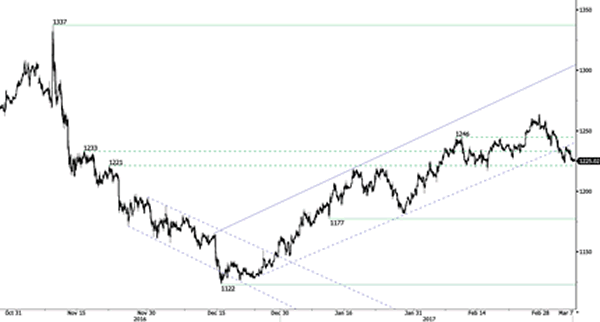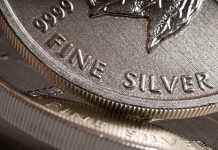News and Events:
Australia’s central bank holds rate, AUD surges
As broadly expected, the Reserve Bank of Australia kept its cash rate target unchanged at a record low of 1.5%. The RBA reiterated its well-known view that the Aussie is overvalued and stated that an appreciating exchange rate would complicate the economic transition that followed the mining investment boost. However, the institution acknowledged the positive development in commodity prices that provided “a significant boost to Australia’s national income”.
Despite the RBA’s positive assessment of the economy, Governor Lowe maintained a cautious stance about Australia’s outlook, recalling that the “medium-term risks to Chinese growth remains”. Indeed, China is Australia’s biggest trade partner as it absorbs around 35% of Aussie total exports. From our standpoint, we suspect that the surge in commodity prices – more specifically iron ore prices – is coming to an end and that a reversal is looming as Chinese stockpiles went through roof while crude steel production remain subdued.
For all these reasons, we believe that the RBA is definitely not on its path to tighten its monetary policy as the inflation gauge is still well below the 2%-3% target band. The year-ended trimmed mean inflation reached 1.6% in December 2016, while the headline gauge hit 1.5%. There RBA is therefore in no hurry to tighten; however should commodity prices consolidate the recent gains, inflation will quickly start to pick-up. Looking at the AUD this morning, it seems that investors consider the latter scenario as highly probable as the Aussie rose 0.30% against the greenback and erased partially last week gains to return above the 0.76 threshold. On our side, we maintain our bearish view on AUD/USD with 0.75 as next target.
On the technical side, a first support lies at around 0.7530-40 (200dma and 50dma), then 0.7519 (Fibonacci 38.2% on December-February rally). Should AUD/USD break these levels, the road will be wide open towards 0.73-0.72.
Evidence of FX intervention as SNB Reserves Surge
The Swiss National Bank’s foreign exchange reserves surged 3.8% to 668.2bn CHF. While the SNB does not generally comment on intervention, the size of the balance sheet expansion indicates that the SNB has been very active in FX markets. This has been the fastest accumulation since December 2014 when the SNB was under siege to defend the 1.200 floor. Data published today suggests that the SNB greater exchange rate flexibility did not account for fear-driven flight of capital out of Europe. The strong demand for CHF indicates just how worried European investors are regarding political developments. Despite an improvement in inflation and the growth backdrop, SNB Jordan continues to define the CHF as “significantly overvalued.” Unfortunately for the SNB the short EURCHF trade remains the cleanest way to hedge mounting European political risk. We anticipate that despite SNB intervention the EURCHF will continue to grind lower. On a side note, judging from the SNB actions they are not concerned about US President Trump administration labelling Switzerland a “Currency Manipulator”.
German factory orders collapse
Financial markets always tend to closely monitor German’s economic data as the country is always acting as the locomotive of the European economy. In particular its industry is the strongest of the Eurozone. Early this morning, factory orders data have been released and have sharply declined to -7.4% which is the worst month decline since 2009. The read is well below the consensus. A decline of -2.5% was expected.
The low interest rates era has helped the German economy but this does not seem sufficient as the demand is clearly weakening. Fundamental data must be compared with survey such as the IFO business climate or expectations which are showing some positivity
The euro barely reacted to that data and remains below $1.06. Optimism still seems to prevail on the market. The German DAX index is trading at all-time high and there is no reason for this move to stop in the short-term as economic expectations are strong for the time being. The ECB next Thursday should not change anything about the monetary policy and whatever the data, we believe that the euro should stay weak and stocks markets overvalued.

Today’s Key Issues (time in GMT):
- Jan Industrial Production MoM, exp -2,50%, last 0,90%, rev 2,30% DKK / 08:00
- Feb Foreign Currency Reserves, last 643.7b, rev 643.9b CHF / 08:00
- Feb Foreign Reserves, exp $2969.0b, last $2998.2b CNY / 08:00
- Feb Budget Balance, last 8.7b SEK / 08:30
- Feb Halifax House Prices MoM, exp 0,40%, last -0,90%, rev -1,10% GBP / 08:30
- Feb Halifax House Price 3Mths/Year, exp 5,30%, last 5,70% GBP / 08:30
- Feb CPI YTD, exp 0,90%, last 0,60% RUB / 09:00
- Feb CPI MoM, exp 0,30%, last 0,60% RUB / 09:00
- Feb CPI YoY, exp 4,60%, last 5,00% RUB / 09:00
- Feb CPI Core MoM, exp 0,40%, last 0,40% RUB / 09:00
- Feb CPI Core YoY, exp 5,20%, last 5,50% RUB / 09:00
- Feb Region Survey: Output Past 3M, last 0,6 NOK / 09:00
- Feb Region Survey: Output Next 6M, last 0,73 NOK / 09:00
- Jan PPI MoM, last 0,60% EUR / 09:00
- Jan PPI YoY, last 0,90% EUR / 09:00
- 4Q GDP Annualized QoQ, exp 0,00%, last 0,20% ZAR / 09:30
- 4Q GDP YoY, exp 0,60%, last 0,70% ZAR / 09:30
- 4Q Gross Fix Cap QoQ, exp 0,60%, last 0,20%, rev -0,50% EUR / 10:00
- 4Q Govt Expend QoQ, exp 0,40%, last 0,50%, rev 0,40% EUR / 10:00
- 4Q Household Cons QoQ, exp 0,50%, last 0,30% EUR / 10:00
- Istat Releases the Monthly Economic Note EUR / 10:00
- OECD Interim Economic Outlook EUR / 10:00
- 4Q F GDP SA QoQ, exp 0,40%, last 0,40% EUR / 10:00
- 4Q F GDP SA YoY, exp 1,70%, last 1,70% EUR / 10:00
- Feb FGV Inflation IGP-DI MoM, exp 0,05%, last 0,43% BRL / 11:00
- Feb FGV Inflation IGP-DI YoY, exp 5,22%, last 6,02% BRL / 11:00
- Jan PPI Manufacturing MoM, last 0,70% BRL / 12:00
- Jan PPI Manufacturing YoY, last 0,78% BRL / 12:00
- 4Q GDP QoQ, exp -0,50%, last -0,80% BRL / 12:00
- 4Q GDP YoY, exp -2,40%, last -2,90% BRL / 12:00
- 4Q GDP 4Qtrs Accumulated, exp -3,60%, last -4,40% BRL / 12:00
- Feb Official Reserve Assets, exp 395.5b, last 390.6b RUB / 13:00
- Jan Trade Balance, exp -$48.5b, last -$44.3b USD / 13:30
- Jan Int’l Merchandise Trade, exp 0.75b, last 0.92b CAD / 13:30
- Feb Vehicle Production Anfavea, last 174064 BRL / 14:20
- Feb Vehicle Sales Anfavea, last 147219 BRL / 14:20
- Feb Vehicle Exports Anfavea, last 37189 BRL / 14:20
- Bank of England Bond Buying Operation GBP / 14:50
- Feb Ivey Purchasing Managers Index SA, exp 58,5, last 57,2 CAD / 15:00
- Jan Consumer Credit, exp $17.250b, last $14.160b USD / 20:00
- Feb ANZ Truckometer Heavy MoM, last -0,80% NZD / 21:00
- 4Q Mfg Activity Volume QoQ, last 2,10% NZD / 21:45
- 4Q Mfg Activity SA QoQ, last 0,40% NZD / 21:45
The Risk Today:
EUR/USD is moving lower. Hourly resistance is given at 1.0679 (16/02/2017 high). Hourly support at 1.0521 (15/02/2017 low) has been broken. The technical structure suggests deeper consolidation below 1.0600. In the longer term, the death cross late October indicated a further bearish bias. The pair has broken key support given at 1.0458 (16/03/2015 low). Key resistance holds at 1.1714 (24/08/2015 high). Expected to head towards parity.
GBP/USD has broken support given at 1.2254 (19/01/2017 low). The road is wide-open for further decline. Hourly resistance is given at 1.2570 (24/02/2017 high). The long-term technical pattern is even more negative since the Brexit vote has paved the way for further decline. Long-term support given at 1.0520 (01/03/85) represents a decent target. Long-term resistance is given at 1.5018 (24/06/2015) and would indicate a long-term reversal in the negative trend. Yet, it is very unlikely at the moment.
USD/JPY is showing limited short-terms buying interest after reversing off base lows. Key resistance is given at 115.62 (19/01/2016 high). The technical structure suggests further weakening towards 112.00. We favor a long-term bearish bias. Support is now given at 96.57 (10/08/2013 low). A gradual rise towards the major resistance at 135.15 (01/02/2002 high) seems absolutely unlikely. Expected to decline further support at 93.79 (13/06/2013 low).
USD/CHF continues to improves after testing 1.0021 support. Hourly resistance is implied by upper bound of the uptrend channel. Key resistance is given at a distance at 1.0344 (15/12/2016 high). Expected to see further strengthening. In the long-term, the pair is still trading in range since 2011 despite some turmoil when the SNB unpegged the CHF. Key support can be found 0.8986 (30/01/2015 low). The technical structure favours nonetheless a long term bullish bias since the unpeg in January 2015.
| EURUSD | GBPUSD | USDCHF | USDJPY |
| 1.1300 | 1.3445 | 1.1731 | 121.69 |
| 1.0954 | 1.3121 | 1.0652 | 118.66 |
| 1.0874 | 1.2771 | 1.0344 | 115.62 |
| 1.0558 | 1.2188 | 1.0152 | 114.02 |
| 1.0454 | 1.1986 | 0.9967 | 111.36 |
| 1.0341 | 1.1841 | 0.9862 | 106.04 |
| 1.0000 | 1.0520 | 0.9550 | 101.20 |












